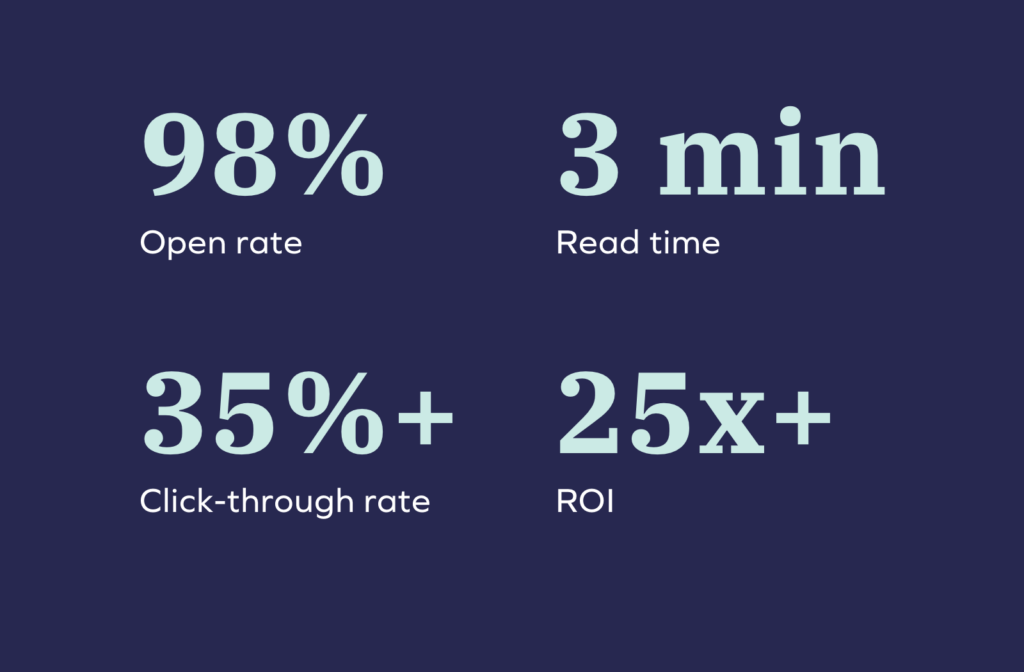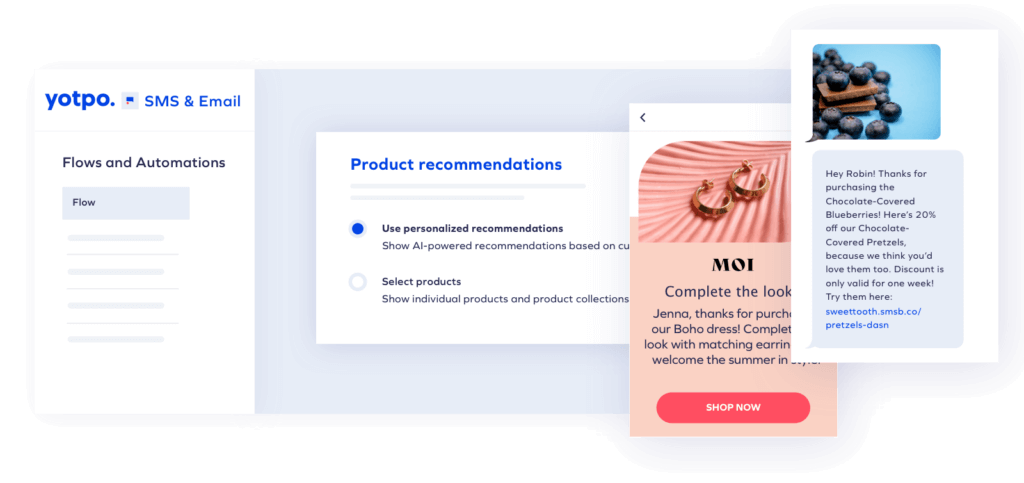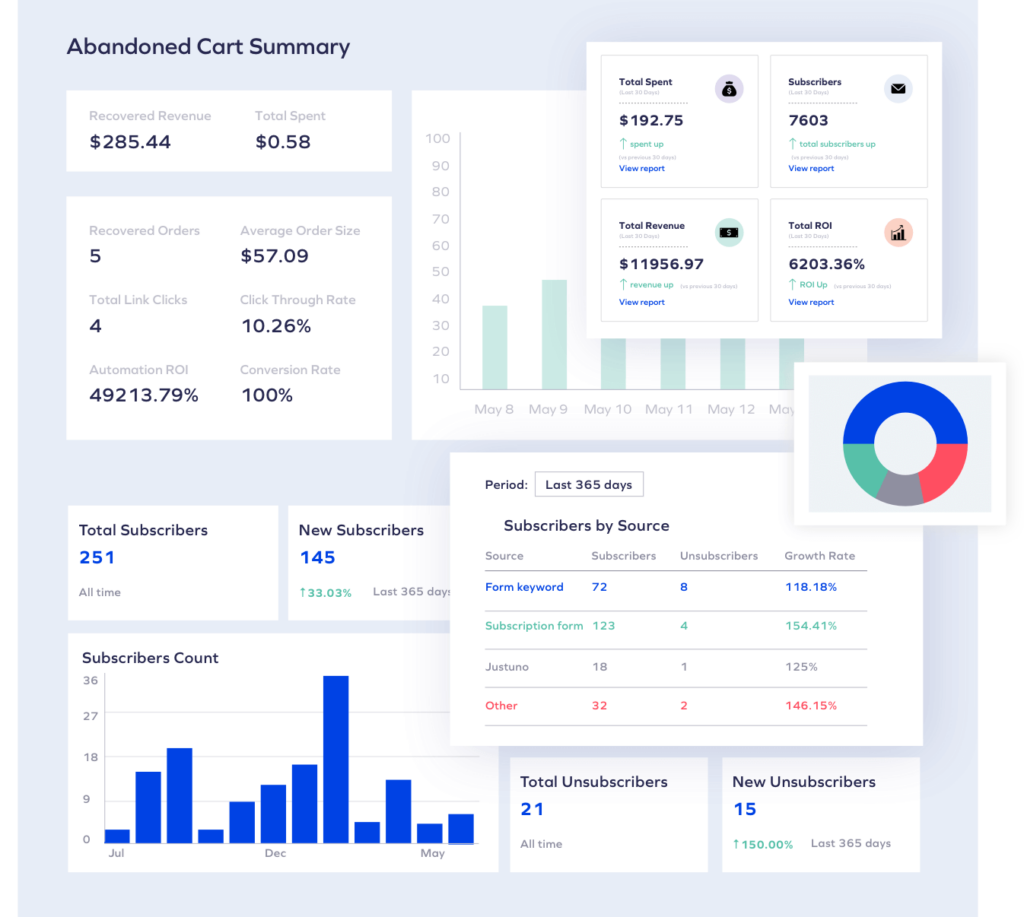SMS is one of the highest-yielding ROI channels available to marketers, but most brands and marketing professionals underutilize it.
With a 98% open rate and over 90% of text messages read within 3 minutes, SMS is the perfect channel of communication between a brand and its customers. More than half of the respondents in a Yotpo survey want to text with their favorite brands. However, 61% of marketers still don’t use SMS marketing.
If you’re one of them – you’re leaving money on the table.
In this blog post, you’ll learn expert-backed SMS marketing strategies that will help you boost the performance of your eCommerce business. You’ll also learn how to turn SMS into your top-revenue channel. Let’s dive in!
Understanding SMS marketing for eCommerce
What is SMS Marketing?
SMS marketing, or text marketing, is a form of marketing where businesses use text messages to communicate with customers.
Depending on your brand’s goal and strategy, you can leverage SMS for various marketing activities. For instance, you can promote your products and collect valuable feedback to enhance customer experience further. You can also use SMS to send essential company updates and announcements and provide customer support. In other words, SMS is a multi-faceted solution for all your marketing needs.
There are two main types of text messages:
- Transactional messages: used to inform customers of the status of their order, payment, shipment, or subscription.
- Promotional marketing messages: used to present a new product or collection, announce a flash sale, offer a personalized discount, etc.
Transactional vs promotional text messages
Wondering what type of text messages you must send? As you’ll find out, transactional and promotional text messages are not in conflict. You don’t have to choose one over the other. In fact, it is essential to weave both transactional and promotional text messages into your SMS marketing strategy. However, there are specific differences.
| What’s the difference? | Transactional texts | Promotional texts |
| Purpose | Informs and educates the customer. | Persuades the customer into taking action. |
| Great for | Letting your customers know order fulfillment status, payment confirmation, delivery status, etc. | Announcing surprise sales, personalized offers, or promoting a product. |
| How frequently? | As frequently as the circumstance requires it. | Not more than four to six times in a month. |
| The tone | Conversational and polite tone, but with a specific purpose to inform. | Polite and friendly tone, with an intent to persuade customers into taking action. |
| What about automation? | Transactional messages can be automated, but it helps to have someone respond to queries that customers make. | Promotional messages are usually automated. |
| Personalization | Personalization is less important than the information you send, but helps. | Personalizing the content is essential for a better ROI and reduced opt-out rates. |
At the end of the day, every e-commerce business needs to have a strategy for both transactional and promotional SMSes. Both must be non-intrusive, respect local telemarketing and privacy laws, and have a clear opt-out strategy. For instance, Yotpo SMS makes it mandatory to insert an opt-out phrase (can be found within the SMS campaign editor) to ensure companies comply with different rules and regulations. This helps them from being marked as spam as well.
SMS is the unseen glue of a mobile-first strategy
When marketers and decision-makers think of implementing a mobile-first strategy, they usually think about mobile apps, improving UX/UI on mobile browsers, and being available on social media for marketing and support operations. However, they often forget that text is still around and is very popular among customers. People prefer being contacted over SMS as long as it is non-intrusive, has their consent, and adds value to their lives. Most importantly, you can use SMS to tie various mobile-first strategies together for a better user experience. Here’s how:
- Connect with customers via SMS when they’re on slower networks, even in the remotest corners of the planet, at predictable costs.
- Use SMS to target customers who do not use your mobile applications. Most people download applications but rarely use them.
- Address customer concerns voiced on social media via SMS to make people feel seen and heard. This is a great strategy to address negative reviews as well.
- Complete the omnichannel experience by being available on text messaging, too. Don’t forget, your customers expect regular order processing/shipping updates. SMS makes this easy, automated, and non-intrusive.
- People’s attention span is limited, as is the length of a typical SMS. Use this to your advantage.
What makes SMS an effective marketing channel?
Contrary to popular perception that SMS is passe, youngsters and adults alike prefer texting to other forms of communication. Mobile commerce sales are expected to reach $700+ billion by 2025. 91% of teenagers regularly send text messages. At the same time, older people use SMS for different reasons — SMS is non-intrusive, is excellent for people with hearing disabilities, and for those who dislike talking over the phone or staring at the screen. In other words, every demographic uses SMS, making it very relevant and effective.
Brands must meet customers where they are and offer frictionless shopping experiences. SMS is mobile-first, customer-first, and privacy-first. Consequently, it can quickly become the greatest asset of your overall marketing strategy. And if you’re wondering if you’ll have the time and resources to manage yet another marketing channel, just don’t – SMS can be fully automated!
But there’s more. Here are some business and tech-oriented reasons why you should start sending SMS right away:
SMS goes hand-in-hand with mobile commerce
46% of respondents in a survey revealed that they spend between five and six hours daily on their cell phones. If you do not use SMS in your mobile marketing strategy, you really are losing something. Here’s how:
- Mobile commerce has primarily depended on email and social media marketing in recent years. However, text messages offer a kind of immediacy and personalization that other channels cannot.
- Texting addresses the issue of customers disabling push notifications sent via mobile apps.
- Text messaging in your marketing mix is vital to make your mobile strategy more effective.
- Don’t forget that everything takes place on your customer’s mobile screen. Hence, you can link SMS with your app or social media or get customers to visit a particular page on their mobile browsers, depending on your marketing goal.
Enables high open rates and engagement
The numbers support implementing an SMS marketing strategy pronto.
- A Gartner study reported 98% open rates and 45% response rates for text messages.
- According to Hubspot, the average open rate for emails across industry verticals was only 38.49%. Most importantly, SMS has a consistent open rate, as long as you’ve created your list genuinely. Email newsletters often go to the promotional boxes of Gmail, for instance, and they’re forgotten and never opened.
- According to a McKinsey study, SMS has high engagement rates worldwide, including in the US.

If you’re looking for a simple and quick channel to elicit the ‘open and read’ action, SMS is it.
Allows for a high level of personalization
SMS helps you connect with your customers in a more meaningful way. As you’re not pressed to add more content or media into those tiny text messages, you can really focus on what truly matters — building valuable customer relationships. Here’s how you can do it:
- Collect relevant data with customer consent and in compliance with rules and regulations.
- Personalize what you collect at a whole new level. Right from your customers’ first names to their previous purchase history and demographic details, you’ll have it all at your fingertips to analyze and segment.
- Track historical data and previous interactions to create hyper-personalized campaigns.
- Use insights to exceed engagement and closeness a customer feels toward your brand online, in comparison to what they experience at a physical outlet.
Tools like Yotpo come integrated with other features like email marketing, payment platforms, and social media. This helps you understand your customers personally and implement targeted marketing and loyalty campaigns.
Makes customer service more efficient
Letting your customers know if their orders were placed successfully, if the payment went through, and if the product was shipped on time can do magic for your customer service. Customers receive automated SMS updates about where their purchase is, and when it can be expected to be delivered. It’s instant and convenient and reduces the number of calls your customers make to your support center. Most importantly, SMS makes your customer service efficient. Let’s see how:
- Omnichannel marketing, the essence of modern eCommerce strategies, only works when you offer seamless customer service across channels.
- Whether customers choose to return goods at your physical store or make a complaint over the phone, you need to have access to all previous interactions and purchase history to offer the best possible customer support.
- SMS is the crucial link that makes customer service more efficient by sending automated and human-generated text messages.
- When you allow customers to choose texting over other modes of communication, you reduce the burden on your customer service executives and save resources.
- The conversational nature of SMS allows you to implement personalized 2-way communication and enables you to be “always on” – available 24/7 just a text away. This helps build trust, loyalty, and enhances customer lifetime value.
And things get even better when e-commerce businesses use SMS marketing.
The benefits of SMS marketing in eCommerce
While SMS marketing helps businesses in almost every industry vertical to connect and communicate with their customers efficiently, it is particularly beneficial and essential for e-commerce companies.
- Enhanced customer communication: You can also use data from your ERP to send personalized promotional messages to customers to clear stock, offer discounts, and retain high-value customers. Similarly, you can send time-sensitive transactional messages informing your customers about payment, shipping, and order statuses.
- Increased customer retention rates: Helps retain existing customers by engaging them with personalized messages on important days such as anniversaries, birthdays, etc. You may even offer personalized discounts and offers on such occasions.
- Understand your customers better: SMS helps you learn more about your customers, especially when they send you messages. The kind of language they use, the information they provide, and their interactions can all be integrated with other tools, such as CRM, for a holistic marketing solution.
- Gain a competitive edge: SMS marketing gives you a competitive edge in the e-commerce industry, as only 55% of brands text their customers. You can use this opportunity to build better customer relationships and outpace your rivals simultaneously.
To reap the benefits of SMS marketing, you’ll also need to follow certain strategies and protocols.
How to run effective SMS marketing campaigns for eCommerce?
Effective SMS marketing campaigns for eCommerce require a lot of thinking, planning, and implementation. In other words, you can’t just send text messages to your customers haphazardly. In this section, we take a look at how you can establish clear goals, and implement tried and tested techniques to make your SMS marketing campaigns a huge success.
Establish clear goals and objectives
The first step toward launching a powerful and effective SMS marketing campaign is having a solid plan. Start with the basics and answer the following questions:
1. What do you want to achieve?
Do you want to promote your latest product, send an announcement for an upcoming store opening, or launch something special for your most loyal customers? Be perfectly clear with the goal of your campaign.
2. Who is this message for?
Segmenting your audience by demographic characteristics or previous purchase behavior will not only help you send more relevant messages and therefore help boost conversion rates but will also save you money, as you’ll send fewer text messages (but to the right people).
3. What is your budget?
Budgeting your SMS marketing campaigns might seem overwhelming at first, but with the right tools and strategy, you can easily build a plan that works for your brand.
Choose the right SMS marketing platform
1. Make sure your vendors are SMS experts.
For your SMS marketing tool to work, the vendor must be an expert in SMS strategy. Hence, choose a tool sold by a vendor willing to help you implement SMS marketing intuitively.
2. Multiple subscription opportunities
Ensure the SMS platform offers multi-channel subscription opportunities on your website, social media, and physical store. Subscriber collection tools include pop-ups and floating website buttons, shareable links and keywords on social media, text to subscribe, and QR codes at in-store locations.
3. Seamless automation
Most importantly, ensure that your SMS platform allows for seamless automation of both transactional and promotional texts. However, you should also be able to respond to text messages manually in a conversational manner.
4. Campaign creation and tracking
Your SMS marketing tool should help you create winning messages and track their performance in real-time. It should offer message templates, comprehensive analytics, subscriber insights, and more.
5. Personalization and compliance with regulation
Choosing a tool that helps you personalize your text messages is essential. However, this also means you must collect and store historical consumer data. Ensure your SMS marketing tool complies with consumer protection laws and industry bodies such as ACMA, CASL, TCPA, CTIA, GDPR, etc.
6. Integrations
Most importantly, your SMS marketing tool should be your one-stop solution for all your marketing needs. You should only have to integrate a few tools to run a full-fledged marketing campaign. It should support email, social media, and other forms of marketing while also allowing you to integrate third-party applications if necessary.
Yotpo offers all this and more. Learn more about our SMS marketing tool here.
Build a high-quality SMS subscriber list
It’s a fact: you can’t have a revenue-driving SMS marketing strategy without an audience. Building a high-quality subscriber list won’t happen overnight, so the sooner you start actively collecting opt-ins, the better.
Another fact: brands that provide a variety of subscriber collection experiences are known to increase collection rates by over 40% MoM.
Not sure where to start? Here are some quick tips on subscriber collection – guaranteed to bring you quick wins (and TONS of new subscribers).
1. Start collecting subscribers at checkout.
Brands that leverage an SMS opt-in directly at checkout see over 45% mobile number capture rates.
2. Enable an onsite pop-up.
Pop-up subscribers are considered one of the most valuable types of SMS audience, with a 76% higher conversion rate and a 38% higher LTV, compared to other subscribers.
3. Don’t limit yourself.
Your customers are everywhere! Brands that take an omnichannel approach enjoy 2x more subscribers and 25x ROI. Leverage your social media channels to turn followers into SMS subscribers. Use keywords or QR codes for cross-channel campaigns and catch shoppers where they are likely to engage with your brand.

Create compelling SMS messages
Now that you have clear campaign objectives and an audience waiting to hear from you, it’s time to think about the most essential ingredient in the recipe for your SMS success: your message.
Your goal? Grab the attention of your subscribers and make them fall in love with your brand or product.
While there are no specific rules on what to say in your message, these simple tricks will help make your SMS more engaging and memorable:
1. Add a visual
MMS messages convert better than SMS. Customers buy with their eyes, so putting your product on top is essential.
2. Make it personal
Approach shoppers with their first names or mention a recently purchased product. This will grab their attention and help create a strong bond with your brand.
3. Add value
Offer time-sensitive deals or a unique offer that is only available to an exclusive segment of your SMS list.
4. Add an incentive
Whether it’s a $10 gift card, a 15% discount, or free shipping – make them an offer they can’t (and won’t) refuse.
5. Use FOMO (Fear of Missing Out)
Urgency and scarcity are proven marketing tactics for customers to act on your offer. Fast. Use phrases such as “hurry up,” “get it before it’s gone,” “offer ends tonight,” “get it before others do,” “while supplies last,” “limited quantities,” etc.
6. Add a pinch of humor if appropriate.
Whether it’s a dad joke around Father’s Day or a Halloween pun – it will surely make your message stick.
7. Interactive SMS
One-to-one messaging always works better than impersonal marketing campaigns. Use your SMS marketing tool to send hyper-personalized messages while complying with data protection and privacy laws.
8. End with a clear CTA
Let customers know what’s expected of them: “buy now,” “shop now,” “grab the deal,” “get the discount,” etc.
Timing and frequency considerations
There is a fine line between effectively using SMS to promote your brand and products and spamming your audience.
When in doubt, ask yourself the following: am I being of value to my customers? If the answer is yes, move forward with this campaign. If not, think of ways to make your SMS marketing more relevant.
With text marketing frequency, a good rule of thumb is to send 4-6 messages per month to your entire subscriber list to keep your brand top of mind and, at the same time, keep unsubscribe rates on the low side. Monitor closely the performance of your campaigns and subscribers’ growth and adjust your strategy accordingly.
The same goes for the timing of your SMS marketing campaigns. Avoid the one-size-fits-all approach and see what works best for your product and audience. There is no clear rule on when to message your subscribers as long as you respect quiet hours and consider your customers’ time zones.
“Some brands over-communicate with existing customers. You wouldn’t write 100 love letters after the first date, so respecting the windows you communicate in and the time of day is important. For example, an existing customer does not give a brand free permission to SMS at 7 pm. Communication needs to be smart and timely.” — Adam Sharon-Zipser, Managing Director, Elephant Room.
Now, you might be wondering what typical transactional and promotional SMSes might look like. Let’s take a look at the different types.
Great examples of SMS marketing automation strategies for eCommerce
SMS marketing automations are custom text messages triggered by specific events. They work in the background of your store 24/7, helping you deliver engaging content at every step of the buyer journey.
Whether it’s welcoming new subscribers or winning back churned customers, SMS automations ensure you won’t miss an opportunity to interact with shoppers, establish credibility and trust, build long-lasting relationships, and drive repeat sales.
Here are 7 must-have SMS marketing automations that will boost the overall performance of your eComm store:
Personalized welcome messages
They say you never get a second chance to make a first impression. The same applies to your subscribers – greet the newest members of your SMS marketing program and make them feel appreciated with a heartwarming message.
New subscriber automations are the quickest way to boost conversions and turn new opt-ins into lifelong customers with a single text. For best results, add a small incentive in the form of a gift voucher or a discount with the first purchase.
Example: Hey Kim, welcome to the family! Thank you for registering for our SMS VIP Club! Here is a $10 gift voucher for your next purchase. Enjoy!
Another great way to approach this is to use your welcome message to initiate a conversation – ask shoppers a specific question and use their response to extend a tailored welcome offer and quickly send them down their personal path to purchase.

Abandoned cart reminders
Did you know that 3 out of 4 visitors add products to their carts but leave your store without making a purchase? These devastating stats show why recovering abandoned carts should be the #1 priority for eCommerce businesses of all sizes.
The good news? Over 33% of abandoned carts can be recovered with a simple text.
Abandoned cart automations allow you to bring high-intent shoppers back to your store, contacting your potential customers a certain period (30 minutes or 24 hours) after they have left their cart. Shoppers will be taken back right where they left off, making it easy and convenient for them to finish the purchase.
Example: Hey Jailene, you left GlamFam without your purchase! Grab it now before items sell out.
Order confirmation and delivery updates
Post-purchase care is often neglected, but the truth is – it’s the easiest way to turn a first-time customer into a loyal brand advocate. More than half (51%) of the respondents in a recent Yotpo survey said they would sign up for SMS just to receive transactional text messages.
Whether it’s an order confirmation or delivery notification, your customers will greatly appreciate timely updates on their phones. It’s easy, direct, and convenient!
Example: Great news, Kevin! Your order 14546 just shipped and is on its way to you. Use this link to track it.
Product recommendations and upsells
You’ve heard this before: it’s about 5 times easier to sell to existing customers than new ones. In fact, 49% of consumers are likely to become repeat buyers if offered a personalized experience by a retail brand, so it’s not surprising that post-purchase cross-and upsells are responsible for 10-30% of a store’s revenue.
Cross-sell or upsell SMS marketing automations help merchants boost AOV and drive repeat purchases by offering shoppers complementary products relevant to their current or previous purchases.
 With the rise of artificial intelligence in eCommerce, you can now leverage AI-powered product recommendations that analyze past purchase behavior and suggest products shoppers are most likely to buy next. On autopilot.
With the rise of artificial intelligence in eCommerce, you can now leverage AI-powered product recommendations that analyze past purchase behavior and suggest products shoppers are most likely to buy next. On autopilot.
Example: Hey Michael, how do you like your new BBQ? Check out our best-selling grilling sets. Limited availability!
Winback messages
Winback automations are a powerful tool for marketers who want to focus on retention, especially now, with the current sky-high customer acquisition costs.
Approach shoppers with a tailored offer after they’ve been inactive for longer periods (30 or 60 days). Think of an enticing way to grab their attention, such as a sneak peek into your upcoming Black Friday sale, a pre-holiday deal to have them beat the crowds, or a flash sale to make them act fast.
Stats show timely and personalized messages can bring back over 18% of lapsed customers.
Example: Hey Jess, long time no see! Check out our brand new collection and benefit from limited free shipping to your door!
Date-triggered messages
Date-triggered messages are automatically sent on special occasions or days, such as birthdays, anniversaries, etc. They help seal the bond between you and your customer and make them feel special and valued.
According to an Experian survey, birthday emails had a 179% unique click rate. Remember, emails have a very low click rate compared to SMS. So we are talking about phenomenal figures!
Depending on the occasion, either send a personalized message or lace your message with a delightful offer. For instance, you may either choose to send a personalized birthday greeting or offer the customer a discount during their birthday month.
Example: Happy Birthday, Lynn! On this special occasion, we are delighted to offer a 20% discount on all products on our website this month. Shop now!
Loyalty offers
Loyalty offers help you sustain existing relationships, retain customers who are about to turn over and build loyalty in the long term.
SMS is a great platform for sending loyalty offers because they are non-intrusive and help your customers bring your brand to their conscious awareness (if they’ve forgotten).
With 71% of customers revealing that being part of a loyalty program makes them feel special, you should start sending those loyalty messages today.
Example: Hey Jessie, how are you doing? It’s been a while since you shopped. How about a 27% discount on whatever you choose to buy?
All said and done, you need to constantly monitor how your SMS marketing campaigns are performing.
Testing and Measuring SMS Marketing Success in eCommerce
As you continue to collect subscribers and engage them with various campaigns and automation, keeping track of your performance will be critical to understanding what works (and what doesn’t) so that you can optimize for success.

Hence, the success of your SMS marketing strategy depends on how frequently and consistently you test. You must conduct A/B testing on all your messages, message campaigns, and strategies. A/B testing will help you predict the success of your SMS marketing strategy and allow you to make changes until you draft the perfect campaign. Do not ignore to revise your copy until it passes A/B testing. In addition to testing, you must also track and measure your key performance indicators (KPIs).
Brands’ goals may differ, but we always recommend tracking the following SMS marketing performance metrics to measure your success and easily identify areas for improvement.
1. Subscriber growth
Subscriber growth is the ratio between SMS opt-ins and SMS opt-outs for a selected period, or, in other words, how many people decided to join or leave your text marketing club. Monitor this metric closely to see where most of your subscribers come from and how to leverage this information to grow your audience further.
Our tip: Take an omnichannel approach and use various tools to collect SMS subscribers at scale, whether at checkout, through an appealing pop-up, or, for example, via QR codes on product packaging.
2. Open rate
This one’s easy. With an open rate of 98%, SMS is the #1 communication channel to ensure your message gets seen.
Our tip: use contact cards to slide in customers’ contacts, further boost recognition, and position your brand as a trusted friend rather than just another unknown number so they are more likely to open your messages.
3. Click-through rate
A click-through rate (CTR) is the ratio between the people who have clicked on a link in a text and the whole group of people you’ve sent that text to.
Our tip: add an appealing visual, a clear CTA, and a pinch of FOMO to nudge subscribers to take action.
4. Conversion rate
The conversion rate shows how many people clicked on a link in your text message and purchased from your store.
Our tip: make sure the link leads directly to your offer, your website is mobile-friendly, and the checkout process is as quick and seamless as possible – for the highest chance of conversion every time.
5. Revenue generated
One of the easiest metrics to measure – how much revenue your SMS marketing efforts generated throughout the selected period.
Our tip: a straightforward trick to drive more revenue is to increase the average order value of your store, as both metrics are in direct correlation. To boost AOV, set a minimum order value for an additional incentive, try volume discounts, or simply group products in bundles.
6. Return on investment
If we need to choose one KPI to “rule them all,” it would be the Return on Investment (ROI). Monitor the ROI of each text message you send to gain valuable insights on what performs well, what doesn’t, and what you need to focus on when planning future campaigns.
Our tip: Focus on your highest-spending customers or replicate the success of your top-performing text marketing campaigns. Use advanced segmentation to approach shoppers with highly relevant offers and make the most out of every text you send.
Elevate Your eCommerce with Yotpo’s SMS Platform
Running an e-commerce business takes work. From managing inventory to ensuring orders are fulfilled on time, your responsibilities are many. By implementing SMS marketing, you can genuinely implement an omnichannel strategy and build long-term customer relationships. SMS marketing helps you grow your eCommerce business, enhance revenue figures, and improve customer satisfaction rates. To scale up your e-commerce business, start using Yotpo’s SMS platform today.
SMS Marketing FAQs
Why is SMS marketing important for eCommerce businesses?
SMS marketing, or text marketing, is a form of marketing where businesses use text messages to communicate with customers. It is crucial for e-commerce businesses due to its high open rate (98%). In addition, more than 90% of text messages are read within 3 minutes. SMS provides a direct and personalized communication channel between brands and customers, increasing customer engagement, trust, and loyalty, ultimately driving revenue for eCommerce stores.
What are the main types of text messages used in SMS marketing?
The main types of text messages used in SMS marketing are transactional messages and promotional marketing messages. Transactional messages are used to inform customers about the status of their orders, payments, shipments, or subscriptions. On the other hand, promotional marketing messages are used to present new products, announce flash sales, offer personalized discounts, and engage customers with compelling offers.
How can I automate my SMS marketing efforts to save time and resources?
Automating SMS marketing can save time and resources while delivering personalized and timely messages to customers. Choose an SMS marketing platform that offers automation features and allows you to set up custom text messages triggered by specific events. Automated SMS campaigns, such as welcome messages, abandoned cart reminders, and winback messages, work in the background 24/7, ensuring you take advantage of every opportunity to engage with customers.
What are abandoned cart reminders, and how can they help recover lost sales?
Abandoned cart reminders are SMS messages sent to customers who added products to their carts but left the website without purchasing. These reminders act as gentle nudges to encourage customers to return to their carts and complete their purchases. E-commerce businesses can recover abandoned carts and drive more revenue by offering limited-time discounts or incentives.
How can order confirmation and delivery updates through SMS improve the post-purchase experience for customers?
Order confirmation and delivery updates through SMS provide valuable post-purchase care, enhancing the overall customer experience. By notifying shoppers about their order status, shipment updates, and delivery details in real time, eCommerce businesses offer their customers convenience and peace of mind. This improves customer satisfaction, fosters trust, and encourages repeat purchases.




